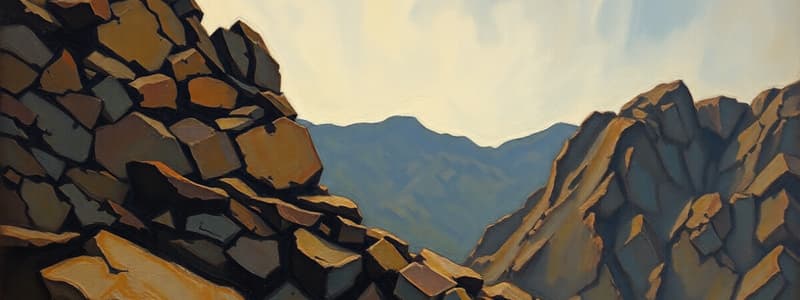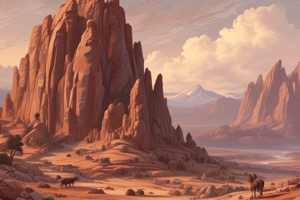Podcast
Questions and Answers
Horizontal layers of sediment are laid down in a process called ________.
Horizontal layers of sediment are laid down in a process called ________.
- erosion
- cementation
- stratification (correct)
- solidification
Parallel layers of mica indicate a ________.
Parallel layers of mica indicate a ________.
- schistose foliation (correct)
- slaty foliation
- gneissic foliation
- phyllitic foliation
Minerals made out of one element are called ________.
Minerals made out of one element are called ________.
- native minerals (correct)
- rock-forming minerals
- synthetic minerals
- compound minerals
________ is a sedimentary rock that can be formed when pebbles and gravel are deposited by fast-moving water or waves.
________ is a sedimentary rock that can be formed when pebbles and gravel are deposited by fast-moving water or waves.
Which two sediments make up the sedimentary rock shale?
Which two sediments make up the sedimentary rock shale?
________ is the process of clastic rocks getting 'glued' together.
________ is the process of clastic rocks getting 'glued' together.
The rock cycle indicates that each type of rock can ________.
The rock cycle indicates that each type of rock can ________.
When a metamorphic rock splits in layers that are parallel to each other, it is called ________.
When a metamorphic rock splits in layers that are parallel to each other, it is called ________.
Which type of sedimentary rock is formed from the compaction and cementation of seashells?
Which type of sedimentary rock is formed from the compaction and cementation of seashells?
What process converts sediment into sedimentary rocks?
What process converts sediment into sedimentary rocks?
Which of the following best describes the term 'luster' in minerals?
Which of the following best describes the term 'luster' in minerals?
What type of magma is characterized by having the highest silica content?
What type of magma is characterized by having the highest silica content?
Which of the following terms is associated with the process of forming sedimentary rocks?
Which of the following terms is associated with the process of forming sedimentary rocks?
What is the primary component of most chemical sedimentary rocks?
What is the primary component of most chemical sedimentary rocks?
Which metamorphic process is primarily involved in the formation of rocks at convergent plate boundaries?
Which metamorphic process is primarily involved in the formation of rocks at convergent plate boundaries?
What occurs when magma cools rapidly, resulting in mineral formation?
What occurs when magma cools rapidly, resulting in mineral formation?
Which of the following is not a test used for identifying minerals?
Which of the following is not a test used for identifying minerals?
Which type of rock forms from the cooling and solidification of magma?
Which type of rock forms from the cooling and solidification of magma?
Flashcards
Stratification
Stratification
The process by which horizontal layers of sediment are laid down, often creating a distinct layering pattern.
Schistose foliation
Schistose foliation
A type of metamorphic rock foliation characterized by parallel layers of mica.
Native minerals
Native minerals
Minerals composed of only one element, like gold or copper.
Conglomerate
Conglomerate
Signup and view all the flashcards
Shale
Shale
Signup and view all the flashcards
Cementation
Cementation
Signup and view all the flashcards
The Rock Cycle
The Rock Cycle
Signup and view all the flashcards
Foliation
Foliation
Signup and view all the flashcards
Phyllitic foliation
Phyllitic foliation
Signup and view all the flashcards
Gneissic foliation
Gneissic foliation
Signup and view all the flashcards
Slaty foliation
Slaty foliation
Signup and view all the flashcards
Sedimentary rocks
Sedimentary rocks
Signup and view all the flashcards
Coquina
Coquina
Signup and view all the flashcards
Basaltic magma
Basaltic magma
Signup and view all the flashcards
Igneous rock
Igneous rock
Signup and view all the flashcards
Luster
Luster
Signup and view all the flashcards
Rhyolitic magma
Rhyolitic magma
Signup and view all the flashcards
Study Notes
Sedimentary Rock Formation
- Sedimentary rocks are formed from sediment (small pieces of rock, mineral fragments, or organic matter)
- Sediment is transported and deposited in layers
- Stratification is the process of horizontal sediment layers forming
- Layers are deposited by water or wind
Foliation in Metamorphic Rocks
- Foliation is the parallel arrangement of minerals in metamorphic rocks.
- Schistose foliation is demonstrated by parallel layers of mica
- Slaty foliation occurs when a rock splits into parallel layers
Native Minerals
- Native minerals are composed of a single element
Conglomerate
- Conglomerate is a sedimentary rock formed from cemented pebbles and gravel
Shale Composition
- Shale is composed of clay and silt
Lithification
- Lithification is the process of cementing clastic rocks together
The Rock Cycle
- The rock cycle describes how rocks can transform into other types of rocks through various processes.
- Rocks can change by forces at Earth's surface and form other rocks.
Metamorphic Rock Foliation
- Slaty foliation is the characteristic of metamorphic rock splitting into layers parallel to each other
Fossils in Rocks
- Fossils are found in sedimentary rocks
Coquina
- Coquina is a sedimentary rock made of seashells
Weathering and Sedimentary Rocks
- Weathering breaks down rocks into sediment
Magma Types
- Basaltic magma forms in rifts or oceanic hotspots.
- Rhyolitic magma has the highest silica content.
Mineral Properties
- Luster refers to the way a mineral reflects light.
Crystal Formation
- Slow cooling magma results in large crystal formation
Mineral Identification Tests
- Hardness, color, and specific gravity are used to identify minerals but not weight.
Chemical Sedimentary Rocks
- Chemical sedimentary rocks are formed by dissolved minerals precipitating
Studying That Suits You
Use AI to generate personalized quizzes and flashcards to suit your learning preferences.



